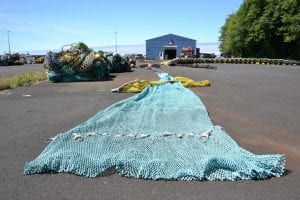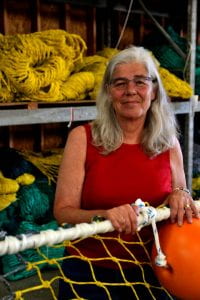Joseph O’Connell
On the central and northern parts of the Oregon coast, worlds meet—land and sea, work and leisure, old and new. In social and cultural terms, no place evokes the region’s contrasts more than Newport’s historic bayfront. Along a short strip of Bay Boulevard, commercial fishing, ocean science, and tourism intermingle. Visitors can buy taffy and souvenirs, visit the wax museum, or descend to an underwater viewing platform. Yet they are never more than a few doors away from one of several seafood processing plants. On the street outside the plants, cautionary signals from forklift operators blend with the vocalizations of an urban sea lion colony. (These animals are either endearing or aggravating; it depends who you ask.) A few yards farther, homemade signs indicate which boats have fresh catches of albacore tuna or Dungeness crab.
Throughout the region, this intimacy of differing communities is the substance of everyday life. Environmental researchers share space with natural resource industries. Spiritual seekers rub elbows with scrappy entrepreneurs. Cold-water surfers cross paths with razor clam diggers. They may look to the ocean for different things, but they all rely on the same tide tables. Sometimes, even the people who live here seem a bit perplexed by the region’s stranger bedfellows. In a casual conversation at a fabrication shop in Waldport, an independent fisher posits that the region “attracts extremes”—extremes of lifestyle and extremes of political persuasion (he’s a progressive.) But he can’t reflect for long; he’s got hundreds of pounds of freshly-caught tuna in tow, and it’s a hot day.
Amidst this mix, creative traditions are one way that the communities of the coast “talk” about who they are. In the crucible of the modern fishing industry, for instance, people who work together forge an array of hard-won customs: techniques for “hanging gear,” methods of preparing salmon cheeks, convictions about good luck. “Never, ever bring a banana onboard a fishing boat,” warns Florence’s Amber Novelli (if you’ve got a banana on board you won’t catch anything). Such traditions function partly as a running commentary about what defines a group, a place, or its history. It’s a commentary that takes place not just within groups, as it does among fishers, but also between them. In Newport, it’s not uncommon for scientists and fishers to meet over beers, trading jokes and points of view about their shared workplace on the Pacific Ocean. Sara Skamser designs, ties, and modifies nets for clients on both sides of that pub table. On a slow day, she might also improvise a quick rope hanger for a tourist who wanders into her shop with a glass float.

A shrimp net, outfitted with a custom “excluder,” awaits repairs outside Foulweather Trawl on Yaquina Bay in Newport.
Lots of traditions “root” people in this part of the coast, but being rooted means something different in each case. When Highway 101 travelers pull over at Karl Kowalski’s chainsaw carving workshop in Seal Rock, they enter a personal museum.

Second-generation Seal Rock chainsaw carver Karl Kowalski poses beside one of his father’s sculptures.
Karl displays not just the work he has for sale but also carvings and memorabilia from a previous era. He inherited these artifacts from his father, who first established the property as Sea Gulch—a sculpture garden and roadside attraction. The items in Karl’s space reflect an attitude about belonging and tell a bigger story about his place in the life of a family, a town, and a region.
Northeast of Newport on Government Hill in Siletz, the Confederated Tribes of Siletz Indians hosts its annual Nesika Illahee Pow-Wow.
On the lawn at the center of the Pow-Wow grounds, dancers from numerous tribes don regalia and compete for prize money. One event, the Women’s Basketcap Special, showcases an iconic form of Siletz material culture–traditional hats woven from natural materials. For the Siletz and other indigenous people of the region, cultural traditions like the Pow-Wow take on significance against a long history and display resilience over colonization and its legacies.
Across Oregon coastal communities, people also adapt cultural traditions to respond to contemporary concerns, especially ecological ones. At the Women’s Expression Session on Agate Beach, two surfers dress as sea fowl and perform an original rap about beach stewardship. In the thick of the parade that opens the Nesika Illahee Pow-Wow, participants carry signs that protest mismanagement of a sewage spill on the Siletz River. And at Foulweather Trawl in Newport, “trawl techs” apply their tying skills to make nets “fish cleaner” with the addition of modifications that minimize “bycatch”—those fish that fishers don’t intend to catch. Whether it’s surfing, fishing, or regalia-making, longstanding cultural forms have an intimate connection to the natural environment. Such creative traditions also function to defend that environment.
Joe O’Connell has ten years of public folklore experience spanning studies of vernacular music, laborlore, and material culture. He completed an MA in Folklore at the University of Oregon in 2009, and fieldwork on the Oregon Coast marks his second collaboration with the OFN, this time in Lincoln and Clatsop counties, the coastal section of Lane County, and with the Confederated Tribes of Siletz Indians. Along with Josephine McRobbie, Joe is a 2019 American Folklife Center Archie Green Fellow. O’Connell and McRobbie have been conducting oral histories with midwives and other birth workers across the state of North Carolina. Joe is also an active folk-rock music recording artist, making music under the band name Elephant Micah. He lives in Durham, North Carolina.



